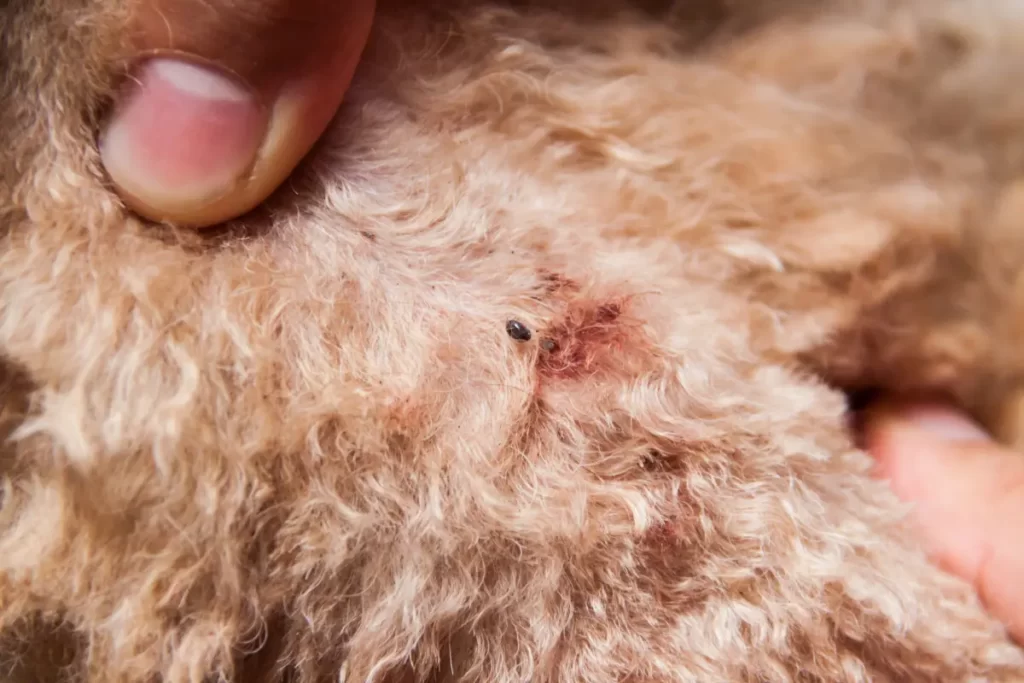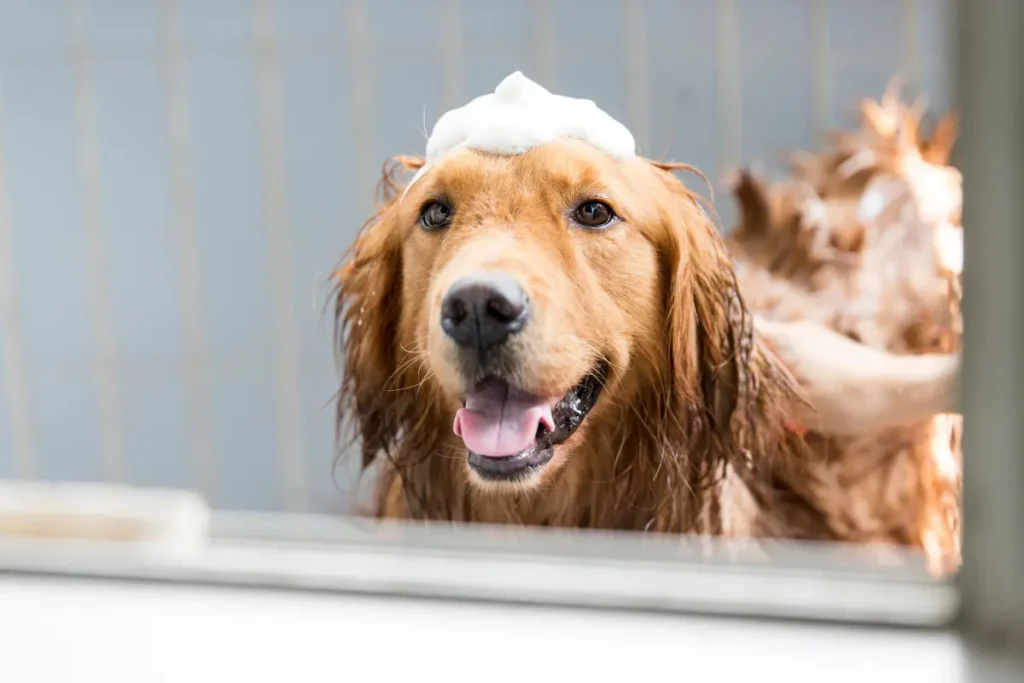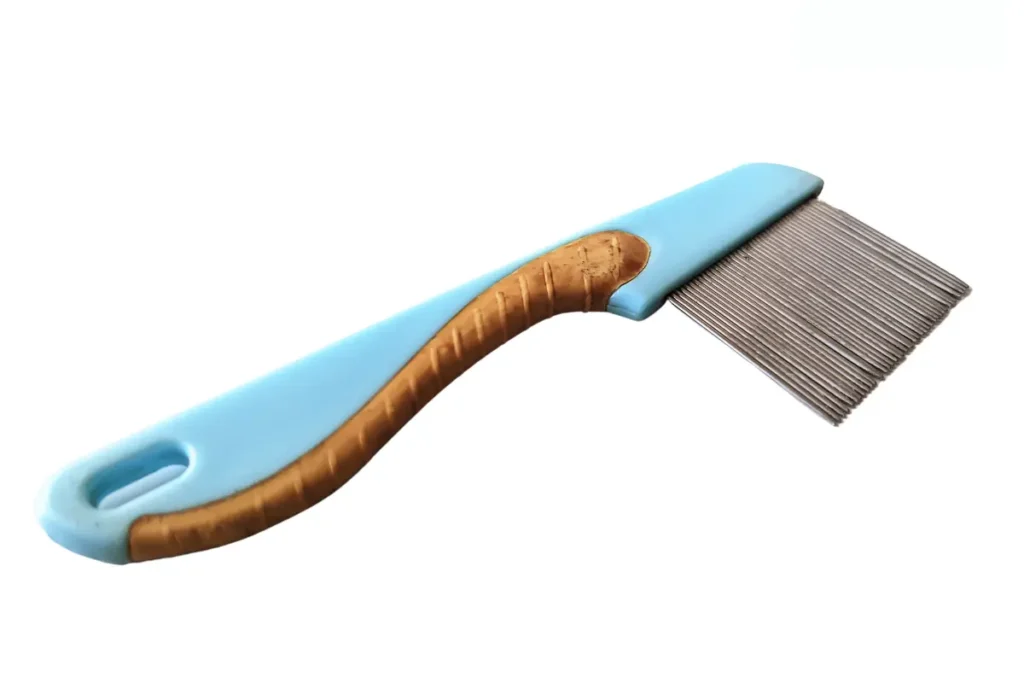Golden doodle puppies may be entertaining, but raising these beautiful dogs properly requires careful planning on the part of the doodle owner. Keeping their coats clean and managing their hair is a big part. When I consider this, the question, “Do Golden Doodles Get Fleas?” pops into my head.
Fleas do indeed infest Golden doodles. These fleas take blood from golden doodles as food. Fleas not only make Doodle’sDoodle’s life miserable by biting him all the time, but they also pose a significant health risk.
Please read the entire post to learn more about the fleas in doodles and how to get rid of them.
Golden Doodles

Golden doodles are a loving crossbreed famous for their intellect and devotion to their owners. Golden Doodles are energetic and active dogs.
They will require brushing more frequently as their coats become curlier. But generally speaking, a golden doodle needs daily brushing to prevent flea infestation. Nevertheless, weekly brushing sessions are sufficient if they have a straight coat or very short hairstyle.
All dogs are susceptible to fleas, but Doodles may be more vulnerable. A Doodle’s hair can hide fleas more effectively than a dog with a regular coat because its textured skin is frequently very thick and curly. It is particularly challenging to spot flea indications because of their fur.
While most Golden doodle owners undoubtedly think of high maintenance when they see their dog’s coat, Golden doodles also need a lot of social engagement and psychological stimulation.
What Do Golden Doodles Fleas Look Like?

Golden doodle fleas are little, insect-like organisms. Flea eggs are oval-shaped, white, and very small. On the other hand, adult fleas are dark brown or black, plainly visible to the human eye, and capable of crawling and jumping.
Although they can occasionally bite humans, fleas only consume the blood of golden doodles. It’s incredible how long a flea can go without food. However, to breed and lay eggs, female fleas must consume a meal of doddle’s blood.
One flea can lay up to 4,000 eggs on the host animal’s fur, so you can imagine how quickly an infestation might spread.
The flea’s life cycle typically lasts two to three weeks, though it can extend if the weather is chilly. Fleas are reddish-brown in appearance and have long, flat bodies that are just a millimeter or so long as adults.
Why Do Golden Doodles Catch Fleas?
Pet-to-pet transmission is the most frequent cause of flea infestation in Golden doodles. The majority of pet infestations occur using this technique. So it stands to reason that if a Golden doodle mixes with other dogs at the flea-ridden dog park, the parasites will probably hop onto the doodle dog.
It’s crucial to thoroughly examine a golden doodle dog if it exhibits flea symptoms and signs. The low back, tail head, and the back of the thighs and groin should all be checked initially. Check for fleas in the doodle dog’s cage, bedding, and toys.
Follow these methods to examine a golden doodle dog’s fur for fleas while performing a flea check. To check for flea movement, divide the hair into sections. Look for black specks, which are flea excrement and partially digested blood from a host and resemble ground pepper or flea soil.
Do Golden Doodles Get Fleas In Winter?

Yes, Golden Doodles get fleas in the winter. Flea populations may decline slightly, especially outdoors, but never entirely disappear.
If temperatures drop below freezing and remain there for a while, fleas are more likely to perish. Even so, it’s not always sufficient. The life cycle of the flea aids in its survival. A female flea can begin laying eggs within 1-2 days of biting the Goldendoodle. In about one month, she can lay up to 10,000 eggs.
These eggs may then find their way into your carpet or other parts of your house. Flea larvae create a cocoon and develop as pupae; they can remain in a cocoon for as long as seven months before emerging as adult fleas.
Although the cold may slow a flea’s life cycle, it can still hatch in the winter. Even if it freezes for a long enough period to kill the adults, the fleas may have already located a warmer location to lay their eggs.
How Do I Know If My Golden Doodle Has Fleas?
The fleas in the golden DoodleDoodle are easily identified by their distinctive markings. In severe infestations, fleas can jump and move on and off the dog’s body.
In less obvious instances, you could observe that dog is restless and is scratching, licking, or chewing on particular parts of her body more frequently than usual. They often shake their heads and pick at their ears.
Check the dog’s skin thoroughly for fleas. Look for small, dark insects that resemble ants but are smaller. Fleas prefer to congregate in the warm, protected areas of a golden doodle’s underarms and crotch. Use your fingers to cut the dog’s fur to expose the skin.
You can notice that the skin seems red and rough if fleas are present, especially if your dog has been scratching. You might see little adult fleas that jump or scramble away fast. You may also notice newly born larvae or cocooned larvae pupating.
[5] Best Chemical-Free Home Remedies For Fleas in Golden Doodles
The ownership of a golden doodle comes with the risk of encountering fleas and ticks. These parasites can bite people, causing itching, hair loss, and skin irritation that can lead to biting. In extreme circumstances, skin allergies might manifest, making life miserable for your beloved Goldendoodle. The following guidelines will help keep fleas away from Golden Doodles.
BATH IN LEMON

Making a simple lemon bath will keep your Goldendoodle smelling good and flea-free. To treat fleas in dogs naturally, mix freshly squeezed lemon juice with double the amount of water, then add a squeeze of your regular pet shampoo.
BATH IN THE LATHER

Existing fleas will be naturally killed by any lathering shampoo made for pets, like Golden Doodle. The best flea treatment is always natural, so choose an organic pet shampoo free of additional chemicals.
After thoroughly lathering the dog, let the shampoo sit for a few minutes to do its job. Before using flea preventive methods, this is a fantastic approach to eliminating already present fleas.
FLEA SPRAY WITH ESSENTIAL OILS

Some essential oils work wonders as flea treatments for golden retrievers. Fleas are naturally repelled by citronella, peppermint, rosemary, tea tree, and lavender. The dog doesn’t mind a spray bottle; add a few drops of the essential oil of your choice to some water before misting the dog’s coat. I
t’s crucial to be aware that certain essential oils, like tea tree oil, can be highly poisonous to dogs if not diluted. Applying a DIY basic oil mixture to doodling should be postponed until a reliable source has established its safety.
FLEA COMB

a flea comb is one method of treating fleas that I would recommend, and it does not necessitate any additional purchases. Flea combs are explicitly made to eliminate fleas and their eggs from your dog’s coat and don’t contain any chemicals. This is an excellent way to get rid of fleas already on your dog before utilizing additional flea home treatments for dogs to prevent further infestations.
FLEA COLLAR WITH CEDAR OIL

Using a homemade flea collar is a clever technique to maintain a dog’s flea protection without having to spray or massage them with the mixture. Purchase or construct a straightforward collar or scarf, then pour a few drops of lavender or cedar oil into the collar after diluting them in wat
[5] Best Flea Medication For Golden Doodles
NOVARTIS CAPSTAR
Veterinarians advise using Novartis Capstar, a top-selling flea treatment product. Nitenpyram has very few adverse side effects and is incredibly safe for dogs. Along with routine flea control measures, you can use the tablets to treat fleas in nursing moms, pregnant Goldendoodles, and puppies as young as four weeks old.
ADVANTIX II K9
The convenient K9 Advantix II is perfect for treating dog fleas. The medication provides long-lasting parasite defense for up to 30 days, eradicating ticks and fleas within half a day. After one day, the drug becomes waterproof, allowing your dog to swim or take a bath without losing the medication’s protective effects.
ADVANTUS
Within an hour of the dog ingesting one dose of the medication, this fast-acting remedy will begin to take effect. Since the composition is made so that the active ingredient in the chew quickly degrades in your dog’s system, it is permissible to repeat the treatment as frequently as once per day if the infestation is severe and persists.
ADVANTAGE II
Fleas don’t have to bite DoodleDoodle to receive a medication dosage because the therapy acts at the skin’s surface when the flea comes into contact with the dog.
A single application of Advantage II takes effect within 12 hours of application and lasts up to 30 days. The dog can take a bath or swim after 24 hours without the product washing off or losing its effectiveness against the dog’s fleas.
VET’S BEST FLEA SPRAY
This spray kills adult fleas, ticks, and flea eggs on contact and is created with 100% natural chemicals. The natural oils used to manufacture the rush are steam-distilled and be potent against parasites while still being mild and safe to use around your house, with loved ones, and with other pets.
Conclusion
The intelligent and devoted golden doodle crossbreed is well known for its high level of attachment to its owners. Fleas do infest Goldendoodles. These fleas take blood from golden doodles as food. Fleas not only make Doodle’s life miserable by biting him all the time, but they also pose a significant health risk.
The fleas in the golden Doodle are easily identified by their telltale markings. Fleas can be seen hopping and moving on and off your dog’s body in cases of severe infestations. Numerous natural therapies and pharmaceuticals are available to keep fleas away from golden doodles.
References
Pawełczyk, O., Asman, M. & Solarz, K. The Discovery of Zoonotic Protozoans in Fleas Parasitizing on Pets as a Potential Infection Threat. Acta Parasit. 65, 817–822 (2020).
Abdullah, S., Helps, C., Tasker, S. et al. Pathogens in fleas collected from cats and dogs: distribution and prevalence in the UK. Parasites Vectors 12, 71 (2019).
Marquez ARA, Eamens K, Westman M, Šlapeta J. Vector-Borne Pathogens in Ticks and Fleas of Client-Owned Dogs in Metro Manila, Philippines. Parasitologia. 2021; 1(4):247-256.

